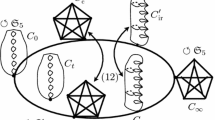Abstract
The Wiman–Edge pencil is the universal family \(C_t, t\in {\mathcal {B}}\) of projective, genus 6, complex-algebraic curves admitting a faithful action of the icosahedral group \(\mathfrak {A}_5\). The curve \(C_0\), discovered by Wiman in 1895 (Ueber die algebraische Curven von den Geschlecht \(p=4,5\) and 6 welche eindeutige Transformationen in sich besitzen) and called the Wiman curve, is the unique smooth, genus 6 curve admitting a faithful action of the symmetric group \(\mathfrak {S}_5\). In this paper we give an explicit uniformization of \({\mathcal {B}}\) as a non-congruence quotient \(\Gamma \backslash \mathfrak {H}\) of the hyperbolic plane \(\mathfrak {H}\), where \(\Gamma <{{\,\mathrm{PSL}\,}}_2(\mathbb {Z})\) is a subgroup of index 18. We also give modular interpretations for various aspects of this uniformization, for example for the degenerations of \(C_t\) into 10 lines (resp. 5 conics) whose intersection graph is the Petersen graph (resp. \(K_5\)). In the second half of this paper we give an explicit arithmetic uniformization of the Wiman curve \(C_0\) itself as the quotient \(\Lambda \backslash \mathfrak {H}\), where \(\Lambda \) is a principal level 5 subgroup of a certain “unit spinor norm” group of Möbius transformations. We then prove that \(C_0\) is a certain moduli space of Hodge structures, endowing it with the structure of a Shimura curve of indefinite quaternionic type.




Similar content being viewed by others
Notes
The name dodecahedral configuration will become clear later.
References
Bertin, J., Romagny, M.: Champs de Hurwitz, Mém, pp. 125–126. Société mathématique de France, Paris (2011)
Cheltsov, I., Shramov, C.: Cremona Groups and the Icosahedron. Monographs and Research Notes in Mathematics. CRC Press, Boca Raton (2016)
Cheltsov, I., Kuznetsov, A., Shramov, C.: Coble fourfold, \(S_6\)-invariant quartic threefolds, and Wiman-Edge sextics, math. AG arXiv:1712.08906
Deligne, P.: La conjecture de Weil pour les surfaces \(K3\). Invent. Math. 15, 206–226 (1972)
Dolgachev, I., Farb, B., Looijenga, E.: Geometry of the Wiman Pencil, I: algebro-geometric aspects. Eur. J. Math. 4, 879–930 (2018). (see also arXiv:1709.09256)
Edge, W.: A pencil of four-nodal plane sextics. Proc. Cambridge Philos. Soc. 89, 413–421 (1981)
Farb, B., Looijenga, E.: Arithmeticity of the monodromy of the Wiman-Edge pencil. Preprint (Nov. 2019). (see also arXiv:1911.01210)
Larcher, H.: The cusp amplitudes of the congruence subgroups of the classical modular group. Illinois. J. Math. 26, 164–172 (1982)
Looijenga, E.: Cellular decompositions of compactified moduli spaces of pointed curves, In: The Moduli Space of Curves, Progress in Mathematics, vol. 29, pp. 369–400. Birkhäuser Boston, Texel Island (1994)
Scott, P.: The geometries of 3-manifolds. Bull. Lond. Math. Soc. 15, 401–487 (1983)
Takeuchi, K.: Arithmetic triangle groups. J. Math. Soc. Jpn. 29(1), 91–106 (1977)
Wiman, A.: Ueber die algebraische Curven von den Geschlecht \(p=4,5\) and \(6\) welche eindeutige Transformationen in sich besitzen. Bihang till Kongl. Svenska Vetenskjapsakad. Handlingar, 21, Afd. 1, No 3, pp. 2–41 (1895)
Zamora, A.: Some remarks on the Wiman-Edge pencil, preprint
Author information
Authors and Affiliations
Corresponding author
Additional information
Publisher's Note
Springer Nature remains neutral with regard to jurisdictional claims in published maps and institutional affiliations.
The first author was supported in part by National Science Foundation Grant Nos. DMS-1105643 and DMS-1406209. The second author is supported by the Chinese National Science Foundation. Both authors are supported by the Jump Trading Mathlab Research Fund.
Rights and permissions
About this article
Cite this article
Farb, B., Looijenga, E. Geometry of the Wiman–Edge pencil and the Wiman curve. Geom Dedicata 208, 197–220 (2020). https://doi.org/10.1007/s10711-020-00517-7
Received:
Accepted:
Published:
Issue Date:
DOI: https://doi.org/10.1007/s10711-020-00517-7



